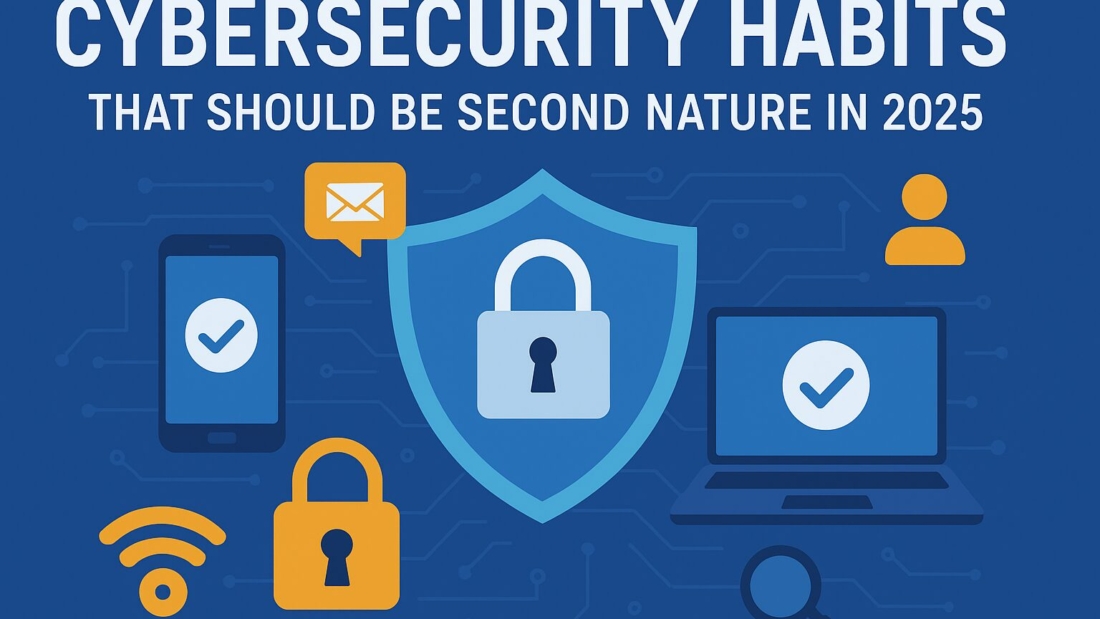In today’s digital-first world, cybersecurity is no longer optional—it’s a necessity. With cyber threats growing more sophisticated and frequent, individuals and organizations must adopt proactive habits to safeguard their data, privacy, and digital assets. As we step into 2025, cybersecurity awareness should be second nature—just like locking your front door at night.
Here are the cybersecurity habits everyone should practice daily to stay safe in an increasingly connected world.
1. Strong, Unique Passwords for Every Account
Weak or reused passwords remain one of the biggest security risks. Hackers often exploit stolen credentials from one platform to gain access to others—a technique known as credential stuffing.
Best Practice in 2025:
Use long, complex passwords (at least 12 characters with numbers, symbols, and mixed cases).
Avoid personal information like birthdays or pet names.
Never reuse passwords across multiple platforms.
Consider using a password manager to generate and store unique passwords securely.
2. Enable Multi-Factor Authentication (MFA)
Even the strongest password can be compromised. MFA adds an extra layer of security, requiring a second verification step such as a fingerprint, face scan, or one-time code sent to your phone.
Best Practice in 2025:
Enable MFA on all critical accounts (banking, email, cloud storage, and social media).
Prefer app-based authenticators (like Google Authenticator, Authy, or Microsoft Authenticator) over SMS codes for stronger protection.
3. Regular Software and Firmware Updates
Cybercriminals exploit vulnerabilities in outdated software, apps, and devices. Manufacturers frequently release patches to close these security gaps.
Best Practice in 2025:
Turn on automatic updates for your operating system, browsers, and apps.
Regularly update IoT devices (smart home gadgets, routers, wearables), which are often overlooked yet highly vulnerable.
4. Zero-Trust Mindset with Emails and Links
Phishing attacks remain one of the most common entry points for cybercriminals. These emails and messages trick users into clicking malicious links or downloading infected files.
Best Practice in 2025:
Never click on links or attachments from unknown senders.
Verify the sender’s email address carefully (watch for small typos or fake domains).
Hover over links before clicking to preview the actual destination.
Remember: When in doubt, don’t click.
5. Protect Your Personal Data
Personal data has become the most valuable currency in the digital age. From social media to e-commerce, every interaction leaves a trail of information that hackers can exploit.
Best Practice in 2025:
Limit what you share online—avoid posting sensitive details publicly.
Use privacy settings on social media to restrict visibility.
Regularly review app permissions and revoke unnecessary access to your data.
6. Secure Your Wi-Fi and Networks
An unsecured network is like leaving your front door wide open. Cybercriminals can intercept your traffic, steal data, or even hijack your devices.
Best Practice in 2025:
Always use WPA3 encryption on your home Wi-Fi router.
Change default router passwords immediately.
Use a VPN (Virtual Private Network) when connecting to public Wi-Fi.
7. Backup Data Regularly
Ransomware attacks are on the rise, locking users out of their files until a ransom is paid. Without a backup, victims often face devastating data loss.
Best Practice in 2025:
Follow the 3-2-1 backup rule: Keep three copies of your data, on two different media, with one stored offline or in the cloud.
Automate backups to ensure consistency.
8. Cyber Hygiene for Mobile Devices
Smartphones are now primary targets for cyberattacks since they store sensitive data and are used for banking, payments, and communications.
Best Practice in 2025:
Install apps only from official app stores.
Review app permissions before granting access.
Use biometric locks (fingerprint or face recognition) instead of simple PINs.
Enable “Find My Device” to remotely lock or wipe your phone if stolen.
9. Security Awareness and Continuous Learning
Cybersecurity is not just about technology—it’s about behavior. Humans are often the weakest link in digital security.
Best Practice in 2025:
Stay updated on common scams and attack trends.
Participate in security awareness training if your workplace offers it.
Encourage family and colleagues to adopt safe online practices.
10. Adopt a Zero-Trust Security Mindset
The “trust but verify” approach is outdated. In 2025, the zero-trust model is key: assume no one and nothing is secure until proven otherwise.
Best Practice in 2025:
Verify devices and users before granting access to networks or systems.
Restrict access to sensitive data on a need-to-know basis.
Use endpoint detection and monitoring tools for early threat detection.
Conclusion
In 2025, cybersecurity isn’t about reacting to threats—it’s about preventing them with everyday habits. From strong passwords to cautious browsing and regular backups, these practices should be second nature for everyone.
Cybersecurity is a shared responsibility: the more we build good habits today, the safer our digital future will be tomorrow.

